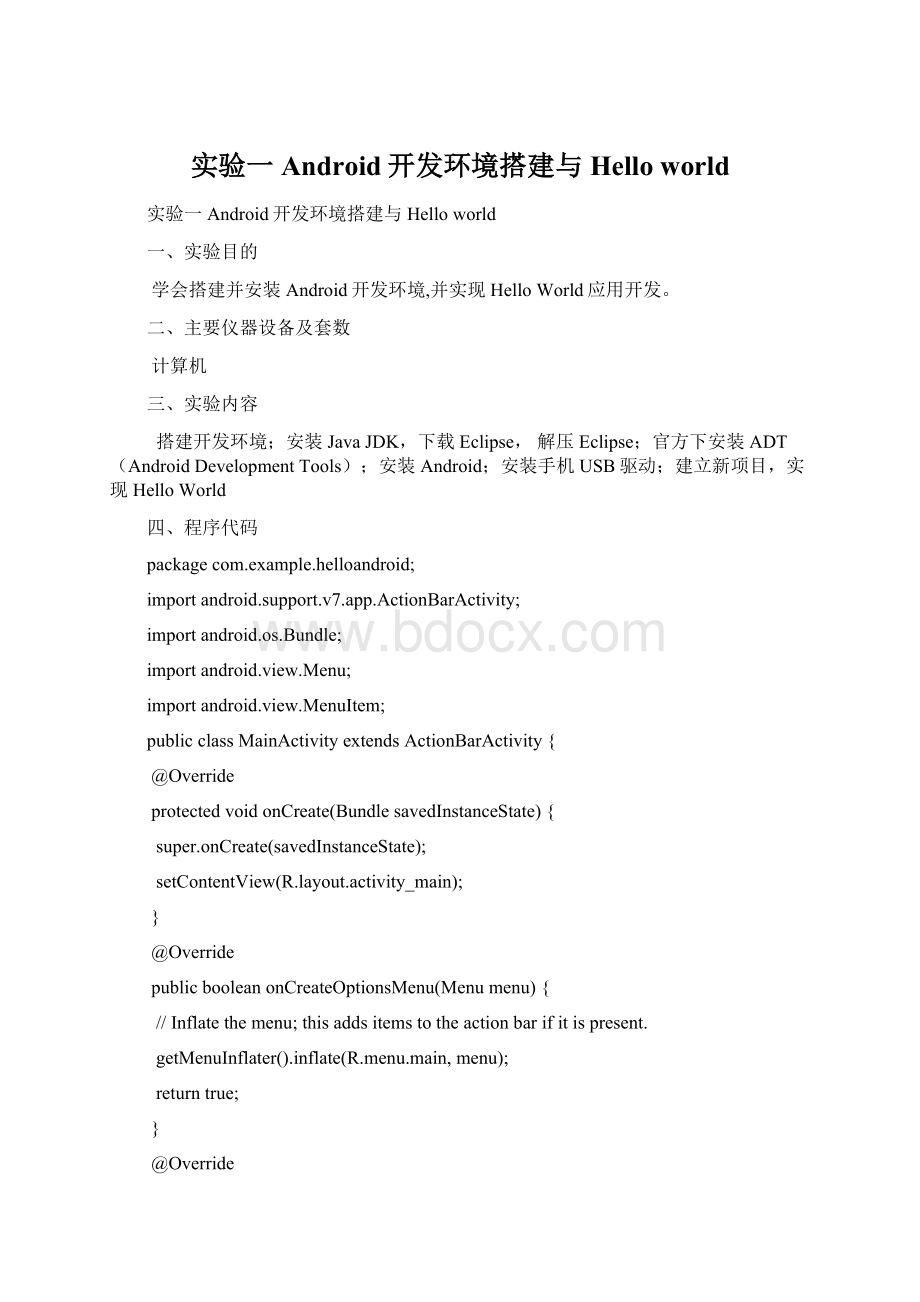实验一Android开发环境搭建与Hello worldWord下载.docx
《实验一Android开发环境搭建与Hello worldWord下载.docx》由会员分享,可在线阅读,更多相关《实验一Android开发环境搭建与Hello worldWord下载.docx(15页珍藏版)》请在冰豆网上搜索。

getMenuInflater().inflate(R.menu.main,menu);
returntrue;
publicbooleanonOptionsItemSelected(MenuItemitem){
//Handleactionbaritemclickshere.Theactionbarwill
//automaticallyhandleclicksontheHome/Upbutton,solong
//asyouspecifyaparentactivityinAndroidManifest.xml.
intid=item.getItemId();
if(id==R.id.action_settings){
returntrue;
}
returnsuper.onOptionsItemSelected(item);
}
五、实验结果
六、实验小结
这个实验很简单,主要是要我们学习Android开发环境的搭建,了解Android应用开发程序的开发过程,生成Android应用程序框架以及配置相应的运行参数。
实验二界面设计:
空间与布局
Android编程基础,UI设计;
使学生了解Android编程原理;
掌握界面控件设计;
掌握控件的事件处理编程。
计算机
了解各种空间的基本功能:
Menu,TextViewEditText,Button,Radiobutton,List;
了解布局layout的应用;
利用布局安排各种控件,设计良好用户界面。
Packagecom.example.Edittext;
Importandroid.os.Bundle;
Importandroid.app.Activity;
Importandroid.view.Menu;
Importandroid.widget.RadioGroup;
Importandroid.widget.RadioGroup.OnCheckedChangeListener;
Importandroid.widget.TextView;
publicclassMainActivityextendsActivity{
RadioGroupbutton01;
TextViewshow;
//获取界面上button01,show两个组件对象
Button01=(RadioGroup)findviewByid(R.Id.button01);
Show=(TextView)findviewByid(R.Id.button01);
//为RadioGro组件的oncheck事件绑定时间监听器
Button01.setoncheckedchangelistener(newOnCheckedChangeListener()
{
publicvoidonCreateOptionMenu(RadioGroupgroup,intcheckedId){
//根据勾选的单选按钮来动态改变tip字符串的值
Stringtip=checkedId==R.id.boy?
“男人”:
“女人”;
//修改show组件中的文本
Show.setText(tip);
});
publicbooleanonCreateOptionMenu(Menumenu){
getMenuInflater().inflate(R.menu.main,menu);
运行:
效果:
通过这次试验,我对安卓编程有了进一步的认识,对各控件的熟练应用会帮我们大大减少少编程量,另外界面的布局还会影响到设计界面的美观。
实验三Android触控监听器的使用
1.掌握Android项目中界面显示的基本方法;
2.掌握OnTouchListener监听器的设计与使用
3.掌握Android手机硬件API的调用方法。
在Android平台下设计实现滑动的方块应用
1.使用屏幕触控,图拽方块移动。
2.暂不考虑横屏切换
控制文件:
packagecom.ex06_03;
importandroid.app.Activity;
importandroid.util.Log;
importandroid.view.MotionEvent;
importandroid.view.View;
importandroid.view.View.OnTouchListener;
intx1=150,y1=50;
TestViewtestView;
publicvoidonCreate(BundlesavedInstanceState){
super.onCreate(savedInstanceState);
testView=newTestView(this);
testView.setOnTouchListener(newmOnTouch());
testView.getXY(x1,y1);
setContentView(testView);
privateclassmOnTouchimplementsOnTouchListener
publicbooleanonTouch(Viewv,MotionEventevent)
{
if(event.getAction()==MotionEvent.ACTION_MOVE)
{//在屏幕上滑动(拖动)
x1=(int)event.getX();
y1=(int)event.getY();
}
if(event.getAction()==MotionEvent.ACTION_DOWN)
{//点击
Log.i("
x="
String.valueOf(x1));
Log.i("
y="
String.valueOf(y1));
}
importandroid.content.Context;
importandroid.graphics.Canvas;
importandroid.graphics.Color;
importandroid.graphics.Paint;
publicclassTestViewextendsView
{
intx,y;
publicTestView(Contextcontext)
super(context);
voidgetXY(int_x,int_y)
x=_x;
y=_y;
/*下面编写绘制小球的代码,参见教材例6-3*/
protectedvoidonDraw(Canvascanvas)
super.onDraw(canvas);
/*设置背景为青色*/
canvas.drawColor(Color.CYAN);
Paintpaint=newPaint();
/*去锯齿*/
paint.setAntiAlias(true);
/*设置paint的颜色*/
paint.setColor(Color.BLACK);
/*画一个实心圆*/
canvas.drawRect(x,y,x+30,y+30,paint);
paint.setColor(Color.GREEN);
/*canvas.drawRect(x-6,y-6,3,3,paint);
*/
界面布局:
<
?
xmlversion="
1.0"
encoding="
utf-8"
>
LinearLayoutxmlns:
android="
android:
layout_width="
fill_parent"
layout_height="
orientation="
vertical"
>
<
TextView
wrap_content"
text="
@string/hello"
/>
/LinearLayout>
简单触摸屏事件指在触摸屏上按下、抬起、滑动的事件,在Android系统中,通过OnTouchListener监听接口来处理屏幕事件当在View的范围内进行按下、抬起、滑动等动作时都会触发该事件。
在本次试验中我学会了简单应用Android触控监听器来操作屏幕,虽然在实验中遇到了一些困难,但还是受益良多。
实验四网络访问与服务
掌握Android网络访问方法。
1.了解手机WEB网站访问编程,通过HttpResponse类,读入网络数据
2.通过网络进行数据访问
3.了解数据库使用
publicclassslide8_3extendsActivity{
PublicStingmyhttpget(Stringurl)throwsException{
Stringout=null;
Try{
HttpClientclient=newDefaultHttpClient();
HttpGetrequest=newHttpGet(url);
HttpResponserequest=client.execute(request);
out=EntityUtils.toString(response.getEntity());
}catch(IOExceptione){
e.printStackTrace();
returnout;
PublicStringmyhttppost(Stringurl,Stringname,Stringvalue)
ThrowEeception{
Stringout=null;
try{
HttpPostrequest=newHttpPost(url);
List<
NameValuePair>
postParameters=newArrayList<
();
postParameters.add(newBasicNameValuePair(name,value));
UrlEncodedFormEntity=newEncodedFormEntity=newUrlEncodedFormEntity(
postParameters);
request.setEntity(formEntity);
HttpResponseresponse=client.execute(request);
}catch(IOExceptione){
@Override
publicvoidonCreate(BundlesavedInstanceState){
FinalTextViewtextview=(TextView)findviewbyid(R.id.TextView01);
FinalEditVieweditview=(EditView)findviewbyid(R.id.EditText1);
finalEditTextname=(EditText)findviewbyid(R.id.EditText2);
finalEditTextvalue=(EditText)findviewbyid(R.id.EditText3);
Buttonbtn=(Button)this.findviewbyid(R.id.Button1);
btn.setOnClickListener(newButton.OnClickListener(){
Publicvoidonclick(Viewv){
textView.setText(myhttpget(editText.getText().toString()+”?
”+name.getText().toString()+”=”+value.getText().toString()));
}catch(Exceptione){
Buttonbtn2=(Button)this.findviewbyid(R.id.Button2);
Btn2.setOnClickListener(newButton.OnClickListener(){
Publicvoidonclick(Viewv){
Try{
textView.setText(myhttppost(editText.getText().toString(),name.getText().toString(),
value.getText().toString()));
}catch(Exceptione){
});
Get:
Post:
在这次试验中,我基本掌握了Android访问网络的基本方法,了解了手机WEB网站访问编程,通过HttpResponse类,读入网络数据,再通过网络进行数据访问,最后还基本学会了数据库使用。
实验五Android平台下手电应用的设计开发
1.掌握Android项目中界面显示的基本方法;
2.掌握OnTouchListener监听器的设计与使用
3.了解Android手机硬件API的调用方法。
1.使用屏幕触控
2.调用相机的闪光点硬件,开启手电功能
3.暂不考虑横屏切换
packagecn.lee.handlight;
importandroid.hardware.Camera;
importandroid.hardware.Camera.Parameters;
importandroid.os.Process;
importandroid.view.View.OnClickListener;
importandroid.view.WindowManager;
importandroid.widget.ToggleButton;
publicclassHandLightActivityextendsActivityimplementsOnClickListener{
privateToggleButtontoggleButton;
privateCameracamera=Camera.open();
/**Calledwhentheactivityisfirstcreated.*/
setContentView(R.layout.main);
toggleButton=(ToggleButton)this.findViewById(R.id.toggleButton1);
toggleButton.setOnClickListener(this);
getWindow().addFlags(WindowManager.LayoutParams.FLAG_KEEP_SCREEN_ON);
//保持屏幕
publicvoidonClick(Viewv){
ToggleButtontb=(ToggleButton)v;
Camera.Parametersparam=camera.getParameters();
if(!
tb.isChecked()){
param.setFlashMode(Camera.Parameters.FLASH_MODE_TORCH);
toggleButton.setBackgroundColor(0x30ffffff);
}else{
param.setFlashMode(Camera.Parameters.FLASH_MODE_OFF);
toggleButton.setBackgroundColor(0xffffffff);
camera.setParameters(param);
protectedvoidonPause(){
//camera.release();
//Process.killProcess(Process.myPid());
super.onPause();
四、实验结果
五、实验小结
能够掌握Android项目中界面显示的基本方法,对监听器的机制和实现监听的四种方式有所了解,会使用Android手机硬件API的调用方法、实现功能,并能独立完成程序增强了自己的动手实践能力,并且成功将实验项目导入手机中且运行成功。